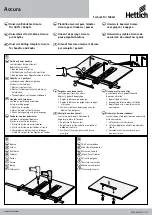
34
1. Disconnect the house wiring.
2. Fit power flow direction sensor 1 and power flow direction sensor 2 or 3 as required depending on the connection
variant you have chosen.
3. Extend the Cat.6 data cable and connect the power flow direction sensor(s) to the SENEC.Home Li using the Cat.6
STP Snap-In metal modular adapter supplied.
7.4 Preparation of the installation location
1. Make sure that there is sufficient space to allow you to install the SENEC.Home Li. Observe the conditions on in-
stallation in section 3.2 Installation.
2. Install a 3-pin B type 16 A miniature circuit breaker into the house wiring for the SENEC.Home Li.
If you are also
installing Econamic Grid, use a 32 A miniature circuit breaker (also B type) instead of the 16 A miniature circuit
breaker.
3. Label the miniature circuit breaker “SENEC”.
7.5 Preparations for assembly
1. Remove the pre-assembled case with its electronics and the SENEC.Inverter from the packaging and get the side
panels and all other accessory parts and tools suitable for the assembly operations ready.
2. Stand the pre-assembled SENEC.Home Li in position and remove the side panels using a suitable tool.
3. Level the SENEC.Home Li so that it is standing stably on the floor. Do this by screwing the feet into the desired
position from inside the case using a slotted head screwdriver or tilt the SENEC.Home Li slightly and adjust the
feet from below.
7.6 Installation of the battery modules
1. Remove the module(s) and accessories from the packaging and get them ready for assembly.
Note!
The packaging and the packaging content must be saved by the end
customer so that he can return the battery module(s) in the event
of
a
guarantee
claim.
Note!
All battery modules must have the same charge status if you wish to add
further battery modules to an existing system (must be added within 12
months). A voltage difference of over 1 V between the battery modules
may
not
be
exceeded.
The battery modules do not switch on if the voltage difference is greater.
Charge the old battery modules fully, then configure the new battery
module to be charged as a master module and charge this fully, too.
















































